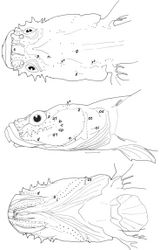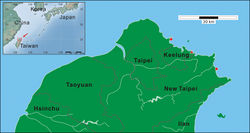Clariger taiwanensis
Contents
- 1 Taxonavigation
- 2 Name
- 3 Type material
- 4 Diagnosis
- 5 Description
- 6 Distribution
- 7 Habitats
- 8 Etymology
- 9 Remarks
- 10 A diagnostic key to all nominal species of Clariger from Japan and Taiwan (adapted from Shiogaki 1988[1] and Akihito et al. 2000[2], 2002[3]):
- 11 Original Description
- 12 Other References
- 13 Images
| Notice: | This page is derived from the original publication listed below, whose author(s) should always be credited. Further contributors may edit and improve the content of this page and, consequently, need to be credited as well (see page history). Any assessment of factual correctness requires a careful review of the original article as well as of subsequent contributions.
If you are uncertain whether your planned contribution is correct or not, we suggest that you use the associated discussion page instead of editing the page directly. This page should be cited as follows (rationale):
Citation formats to copy and paste
BibTeX: @article{Jang-Liaw2012ZooKeys199, RIS/ Endnote: TY - JOUR Wikipedia/ Citizendium: <ref name="Jang-Liaw2012ZooKeys199">{{Citation See also the citation download page at the journal. |
Ordo: Perciformes
Familia: Gobiidae
Genus: Clariger
Name
Clariger taiwanensis Jang-Liaw & Gong & Chen, 2012 sp. n. – Wikispecies link – ZooBank link – Pensoft Profile
Type material
Holotype: 28.3 mm SL, Taiwan, Keelung City, Chau-Jin Park, 25°8.48'N, 121°48.140'E, tidal pool, 31 May 2011, Y. H. Gong (NTOUP-2011-11-062).
Paratypes: 1 specimen, 29.0 mm SL, same locality as holotype, 5 June 2006, I-S. Chen (NTOUP-2006-06-156). 5, 26.4–35.5 mm SL, Taiwan, New Taipei City, Yeliu, 25°12.08'N, 121°41.62'E, tidal pool, 7 November 2000, S. C. Wang et al. (NMMSTP 01302). 1, 30.0 mm SL, same locality as holotype, 1 November 2011, Y. H. Gong (NTOUP-2011-11-057). 1, 30.9 mm SL, Taiwan, New Taipei City, Aodi, 25°3.25'N, 121°55.81'E, tidal pool, 1 July 2011, tidal pool, Y. H. Gong et al. (NTOUP-2011-11-059).
Diagnosis
Clariger taiwanensis can be distinguished from other congeners by the following unique combination of features: (1) fin rays: dorsal-fin rays III, I/8; anal-fin rays modally I/8; and pectoral-fin rays modally 19 (2 free +16+1 free); (2) head with longitudinal dermal ridge including 6 barbels; and (3) specific coloration pattern when alive: head and trunk dark brown with scattered pale spots and blotches; cheek, ventral portion of head sometimes pale with deep brown spots; pectoral-fin base with a dark brown band; and caudal fin mostly dark brown proximally and with alternating and irregular dark brown and pale bands distally.
Description
Body rather slender, cylindrical anteriorly and laterally compressed posteriorly (all morphometric data are shown in Table 1). Head flat and depressed. Eye small. Interorbital region wide, bony interorbital width more than twice diameter of eye. Horizontal, infraorbital dermal ridge on upper part of cheek with 6 barbels (Fig. 1).
Snout flat and rather short. A pair of distinct longitudinal dermal folds beside nasal tubes on snout. Anterior nasal opening in forward-facing short tube, and posterior nasal opening round, flat. Mouth rather large, maxilla extending to vertical through rear margin of orbit. Teeth minute, jaws with 3–5 rows of conical teeth, teeth in outer rows largest in both jaws. Tongue margin bilobed anteriorly. Gill opening somewhat restricted, extending only slightly below lower margin of pectoral-fin base. Anus located anterior to vertical through origin of second dorsal fin. VC 14 + 18 = 32 (9 specimens). Trunk and head entirely naked.
Fins: D1 III (9 specimens); D2 I/8 (9); A I/8 (8)or I/9 (1); P 19 (2 + 16 + 1) (8) or 20 (2 + 17 + 1) (1). D1 very short in height and length. D2 and A of similar size and shape. A origin just in front of D2 origin. D2 origin on vertical between 1st and 2nd branched rays of A. P small and rounded, its length about equal to postorbital length, with 2 thin free, filamentous rays dorsally and 1 free, filamentous ray ventrally. C rounded. V with round sucking disc with complete frenum.
Head lateral-line system: Head canals: head lacking sensory canals and head pores (as for genus). Sensory papillae: all infraorbital sensory papillae arranged in longitudinal pattern. Row a long and extending forward to below nostrils. Row b extending from anterior region of dermal ridge to posterior region of cheek. Row c long, running below the dermal ridge. Single cp located near row c. Row d located just above upper lip, row d1 well separated from row d. Rows ot and oi well separated. Row p surrounding orbit in interorbital region.
Colouration in fresh and preserved specimens: Head and trunk mostly dark brown with scattered pale spots and blotches when alive. Some individuals with larger pale spots in ventral half of trunk. Cheek, ventral portion of head, and underside of anterior portion of trunk sometimes pale with deep brown spots. First dorsal fin translucent with brown dotted spinous rays. Pectoral and second dorsal fins translucent with small deep brown spots. Pectoral-fin base with a dark brown band. Anal fin translucent with a few dark brown spots mostly on the branched rays. Caudal fin mostly dark brown proximally and with alternating and irregular dark brown and pale bands distally.
Long preserved specimens with similar overall dark pattern as described above except disappearance of body pale spots.
Distribution
The new species has only been found from the coastal regions of Taipei County as well as Keelung City, Taiwan. It is highly likely that it represents an endemic marine gobiid species of Taiwan (Fig. 3).
Habitats
Clariger taiwanensiswas found in tidal pools with gravel on the rocky substratum of northern coast of Taiwan. The habitat also supports other marine gobies, including several Bathygobius spp. (dominant), Eviota spp, Gobiopsis spp. and Priolepis semidoliata, as well as the Luciogobius spp.
Etymology
The specific name, taiwanensis, is in reference to the type locality from the coastal rocky shores of northern Taiwan.
Remarks
Clariger taiwanensis shares a morphological similarity (infraorbital dermal ridge with several distinct cheek barbels) with the following four species: Clariger cosmurus, Clariger exilis, Clariger papillosus, and Clariger chionomaculatus. Cheek barbels are lacking in Clariger sirahamaensis. In addition to differences in cheek barbels, the new species can be separated from Clariger sirahamaensis by the pattern of pigmentation on the caudal-fin: fin dark brown proximally with dark brown and pale bands distally in Clariger taiwanensis vs. fin uniform grayish black with a pair of white spots on basal regions of both upper and lower lobes in Clariger sirhamaensis. Clariger taiwanensis can be separated from Clariger chionomaculatus by the number of free pectoral-fin rays (2 free rays dorsally vs. 1); and coloration (no large white marks on trunk vs. several large, round white marks on upper half of trunk). Clariger taiwanensis can be distinguished from the remaining three nominal species, Clariger cosmurus, Clariger exilis, and Clariger papillosus by the following features: (1) fin-rays counts: second dorsal-fin rays 8 vs. 10–13 in others; anal-fin rays 8 vs. 9–11; and (2) squamation: body entirely naked vs. body scaled at least on caudal peduncle.
So far as is known, Clariger taiwanensis is the only species of Clariger found outside Japan, now known from the subtropical island of Taiwan. It is very essential to survey more comprehensively the coastal waters of Taiwan as well as southern China to obtain a better understanding of the species diversity, distribution, and evolutionary history of Clariger and other members of the Luciogobius complex.
| Type status | Holotype | All type specimens | |||
|---|---|---|---|---|---|
| Sample No. | 1 | 9 | |||
| min | max | mean | standard deviation | ||
| Total length | 34.4 | 30.3 | 41.0 | ||
| Standard length | 29.3 | 26.4 | 35.5 | ||
| In SL (%) | |||||
| Head length | 24.4 | 22.8 | 26.7 | 25.3 | 1.2 |
| Snout to 1st dorsal fin origin | 50.0 | 43.6 | 50.0 | 45.8 | 2.1 |
| Snout to 2nd dorsal fin origin | 63.4 | 61.7 | 65.6 | 63.4 | 1.3 |
| Snout to anus | 63.5 | 56.6 | 63.5 | 59.8 | 2.3 |
| Snout to anal fin origin | 64.5 | 60.3 | 65.5 | 63.1 | 1.7 |
| Caudal peduncle length | 21.8 | 20.4 | 24.2 | 21.9 | 1.4 |
| Caudal peduncle depth | 9.9 | 9.9 | 12.5 | 11.1 | 0.8 |
| 1st dorsal fin base | 4.0 | 4.0 | 7.1 | 5.3 | 1.0 |
| 2nd dorsal fin base length | 16.6 | 15.1 | 19.0 | 16.7 | 1.3 |
| Anal fin base length | 16.6 | 15.4 | 19.4 | 16.9 | 1.5 |
| Caudal fin length | 19.6 | 14.7 | 19.7 | 17.1 | 1.9 |
| Pectoral fin length | 13.6 | 13.1 | 16.8 | 14.6 | 1.3 |
| Pelvic fin length | 9.7 | 9.7 | 12.5 | 11.2 | 1.0 |
| Body depth at pelvic fin origin | 11.0 | 10.4 | 11.0 | 10.7 | 0.2 |
| Body depth at anal origin | 11.5 | 11.4 | 13.5 | 12.6 | 0.8 |
| Body width at anal origin | 8.5 | 8.5 | 12.2 | 10.3 | 1.1 |
| Pelvic finorigin to anus | 35.2 | 30.9 | 38.0 | 33.9 | 2.2 |
| Gap between bases of two dorsal fins origin | 16.5 | 16.5 | 20.3 | 18.4 | 1.3 |
| In HL (%) | |||||
| Snout length | 23.8 | 21.3 | 25.4 | 23.5 | 1.3 |
| Eye dismeter | 14.1 | 11.3 | 14.3 | 13.3 | 1.2 |
| Postorbital length | 67.4 | 63.6 | 69.9 | 67.4 | 2.3 |
| Interorbital width | 16.5 | 14.4 | 19.6 | 16.3 | 1.5 |
| Head width | 54.1 | 54.1 | 66.0 | 58.3 | 4.0 |
| Lower jaw length | 35.8 | 31.3 | 38.5 | 35.0 | 2.5 |
A diagnostic key to all nominal species of Clariger from Japan and Taiwan (adapted from Shiogaki 1988[1] and Akihito et al. 2000[2], 2002[3]):
Original Description
- Jang-Liaw, N; Gong, Y; Chen, I; 2012: A new marine gobiid species of the genus Clariger Jordan & Snyder (Gobiidae, Teleostei) from Taiwan ZooKeys, 199: 13-21. doi
Other References
- ↑ 1.0 1.1 Shiogaki M (1988) A new gobiid fish of the genus Clariger from Mutsu Bay, northern Japan. Japanese Journal of Ichthyology 35: 127-132.
- ↑ 2.0 2.1 Akihito S, Ikeda Y, Sugiyama K (2000) Suborder Gobioidei. In: Nakabo T (Ed). Fishes of Japan with pictorial keys to the species. Second edition, Volume 2, Tokai University Press, Tokyo: 867-1748. [in Japanese]
- ↑ 3.0 3.1 Akihito S, Ikeda Y, Sugiyama K (2002) Suborder Gobioidei. In: Nakabo T (Ed). Fishes of Japan with pictorial keys to the species. Tokai University Press, Tokyo: 867-1749.
Images
|

